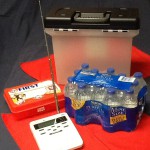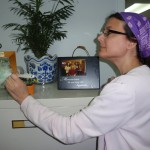by Elizabeth | Jun 27, 2014
 Going to the beach or pool is a popular summer activity but did you know a child can drown in as little as one inch of water? Drowning is usually quick and silent. A child will lose consciousness two minutes after submersion, with irreversible brain damage occurring should the child survive. According to the Consumer Product Safety Commission, at least 350 children die each year from drowning, with most occurring in the summer months.
Going to the beach or pool is a popular summer activity but did you know a child can drown in as little as one inch of water? Drowning is usually quick and silent. A child will lose consciousness two minutes after submersion, with irreversible brain damage occurring should the child survive. According to the Consumer Product Safety Commission, at least 350 children die each year from drowning, with most occurring in the summer months.
Keep an eye on young children and prevent them from drowning. Here are a few points to consider when you are around water:
If you have a pool or spa, install a 4-foot fence around it. Besides lowering your insurance premiums, you will prevent direct access to the pool. Children are curious and move quickly; a “self-locking” latch on the gate provides the best obstacle for young children who might want to jump into the pool.
Install safety drain covers. These devices prevent a body part, hair, or clothing from being trapped by the drain cover. All public and private pools as well as spas are required to be fitted with a drain cover per the Virginia Graeme Baker Pool and Spa Safety Act of 2007. For specifications, visit www.poolsafely.gov.
Supervise your child. The most important preventive tactic is to supervise your child around water at all times. This means actively watching them, keeping them within arms’ reach, and not just glancing up every now and then. Don’t assume they will splash and yell for help if they get into trouble. Children can drown quietly in just a few minutes.
Learn to swim. Children can take formal swimming instruction from the age of four years. Water safety skills are included in the training. Swimming programs are available for younger children and babies, but the emphasis is on building confidence and encouraging the child to enjoy water, rather than teaching them to swim. However, children under age five may not be able to use these skills in an emergency so never rely on this to keep them safe.
Use flotation devices. If you buy personal flotation devices, like inflatable vests, make sure they conform to U.S standards – always check the label. You should think of these devices as something to help familiarize your child with water, not as a safety item. A flotation device is not a replacement for supervision. Always supervise your child, even when they are wearing their personal flotation device, in case they tumble upside-down or slip through the vest.
At the beach: Supervise your child at all times – don’t assume that a beach that was safe in the past is safe now, since the action of waves, weather, and wind can influence depth and currents. If the beach uses a color-coded flag warning system, check the flag color and heed the guidelines. Only take your child to beaches with lifeguard patrols. Make sure your child swims only in the protected area. Teach your child to float and raise an arm to signal for help from a lifeguard.
Going to the beach or pool is a lot of fun – keep it safe and always be alert around children. Have a great and safe summer!
by Elizabeth | May 28, 2014
 May 25 – 31, 2014 is National Hurricane Preparedness Week.
May 25 – 31, 2014 is National Hurricane Preparedness Week.
This week is a good time to prepare your family, property, and pets for severe weather situations. The dangers of a hurricane are numerous: heavy rainfall, flooding, high winds, tornadoes, and in our coastal areas, high tide and rip currents. UF/IFAS Extension has information to help you prepare for the season.
1. Create a plan for your family. Where can your family go in case of an evacuation? Do you plan to stay put and hunker down until the storm passes? Is your house “secure” enough to sustain high winds?
2. Organize your important papers. When it comes to preparing for weather emergencies, knowing where your important documents are is as important as having a plan for your family. Having all your documents up-to-date, accessible, and portable can make a big difference at a tense time.
3. Check your insurance. Will any of the policies you hold pay for temporary shelter, replacement clothing, furniture, or other items if you are affected by a hurricane? Are floods covered in the policy? What is the amount of your hurricane deductible? Visit the Federal Emergency Management Agency (FEMA) or the Florida Disaster Recovery website for more information. Find out whether you can flood-proof your home now.
4. Plan for your pets. Include the welfare of your pets in your plan. Many public shelters do not allow pets so make arrangements to board your animals. Keep ID tags and vaccinations up to date. Prepare a pet evacuation kit, including food and water for one week, a manual can opener, medications, medical/vaccination records, a pet carrier, and bedding. Planning can help ensure safety for you and your pets during a weather emergency.
Bookmarks for more information:
If a hurricane affects you this year, return to this website for tips on recovery and information about your rights.
by Amy Mullins, PhD, RDN | May 13, 2014
Parents and guardians across America work hard everyday to put food in the mouths of their families. We all have to make choices in the foods we eat and provide for our children. This process of planning, shopping, and preparing healthy meals is challenging, but especially for those that have limited income and resources. These families that struggle for food security put themselves at risk for a host of nutrition-related chronic diseases including obesity, high blood pressure, cardiovascular disease, and diabetes.

EFNEP teaches families how to shop for healthy foods, plan and cook meals, save money on food purchases, and incorporate physical activity into their lives.
Over 26% of Leon County’s population is living below the poverty level, which is much higher than the 16.5% of Florida’s total population. In addition, a relationship between income level and overweight status has been established. Of the adults in our county that make less than $25,000 per year, over 70% of them are overweight or obese. These are scary statistics that bring the problems of poor nutrition and limited-income to light.
Having access to nutritious food is a good first step toward putting healthy meals on the family’s table. Surprisingly, only 77% of eligible Floridians in 2010 asked for and received assistance through the Supplemental Nutrition Assistance Program (SNAP). Sadly, it seems that a very large number of eligible Floridians are not getting the help that they need to feed their families.
How can parents and caregivers make the most of their food budget and make healthier choices when planning, shopping, and preparing meals? This is where nutrition education can play a key role to ultimately improve the diet and health of the total family. The Expanded Food and Nutrition Education Program (EFNEP) is offered in over 10 counties in Florida, including Leon County, and is designed to empower families to practice and adopt positive nutrition and lifestyle behaviors. Classes are free and consist of a series of 8 interactive lessons that teach adult participants how to shop for healthy foods, plan and cook meals, save money on food purchases, and incorporate physical activity into their lives.
Classes are offered throughout the county at various community sites. If you are interested in starting a class with your group, church, or worksite, or to find out more information about EFNEP, contact Amy Mullins, Registered Dietitian and Family and Consumer Sciences Agent at UF IFAS Leon County Extension, amymullins@ufl.edu or 850-606-5203. Learn more about SNAP eligibility and benefits by visiting http://www.fns.usda.gov/

by Ginny Hinton | May 12, 2014

New bill would require booster seats for children four years old through age five.
For several years, Florida has been the most dangerous state for children between the ages of 4 and 10 traveling in vehicles. Florida is currently one of only two states in the nation that lacks a booster seat bill for older children – and the only state that allows 4-year-olds to ride in an adult seatbelt.
Booster seats are needed for the simple reason that seat belts are designed to fit adults – specifically the “average” adult male. When a child under age 8 (on average) or under 4’ 9” tall and 80 pounds sits in an adult seatbelt, the lap belt tends to ride up onto his or her stomach. In a crash the belt tightens to keep the child from being ejected. It cuts through the soft stomach and the first bone to stop it is the spinal cord. This is known as “seat belt syndrome”. It can cause severe injuries including internal bleeding and even paralysis. A booster seat “boosts” the child up about six inches so the belt fits below the stomach and can restrain the child properly without causing injury. Using a booster seat reduces your child’s risk of injury by about 60%.
In Florida, some kids are about to get a safety “boost”. The Florida House and Senate just passed the revisions to Florida Statute 316.613 with Bill 225. If signed by Governor Scott, the new regulations will take effect on January 1, 2015. The new law will require children aged 4 through 5 years old to travel in a car seat or booster, NOT an adult seat belt. Unpaid drivers who are not in the child’s immediate family, children being transported for medical emergencies and children with a medical condition necessitating an exception are exempt from the law.
While this law by no means provides adequate protection for Florida’s older children, it is at least a step in the right direction. By a slim margin, Florida will no longer be the most unsafe state in the nation for child passengers.
by Dorothy C. Lee | Apr 14, 2014

Photo credit: Dorothy C. Lee
Spring is officially upon us. There are few rites of Spring more familiar than the annual Spring Cleaning. It is easier and healthier to live in a clean, well-organized home. Spring Cleaning doesn’t have to be synonymous with drudgery, though.
The key to cleaning is being organized and familiar with the uses of different cleaning products. Today’s cleaning methods and equipment make it more efficient and economical to clean. Be an informed consumer when selecting household cleaning supplies. Selecting a few all-purpose cleaners is more economical and requires less storage space.
Make it easy: Get organized. Gather cleaning supplies. Select a few all-purpose cleaners. Put all of your cleaning supplies, brushes, gloves, rags, etc. into one basket and take it with you as you move from room to room.
Clean with ease. Here are some tips that can help you:
- Clean as you go. For example, make your bed as you get out of it.
- Perform preventive measures to avoid big cleaning jobs later. For example, change filters in heating and cooling equipment regularly.
- Plan ahead. Make a list and check off items as you complete the chore. Establish a flexible cleaning schedule.
- Make sure to follow manufacturers’ directions for use and care of items.
- Incentivize by establishing a goal and rewarding yourself when you’ve accomplished it.
- Get in a cleaning mindset. Put on an exercise DVD and think of cleaning as a workout instead of a chore, or put on music you like to move to and let it energize you.
Consider making your own household cleaning supplies…Granny did! Try baking soda, vinegar, and ammonia for cleaning. These old-fashioned cleaners still work today. Making your own cleaners can cost less and be environmentally safe.
Safety considerations should always be followed when making household cleaning supplies. Never mix chlorine bleach with any other cleaning agents, especially ammonia or vinegar. The combination can create toxic fumes. Do not store cleaning supplies in containers that once held food or beverages – this can lead to mistaken identity and accidental poisoning. Clearly label each container. Store all cleaning supplies out of reach of children. Mix cleaning solutions in a well-ventilated area and clean up after using toxic substances. Store containers tightly closed.
Many household cleaners can be made from inexpensive household ingredients. Following are a few DIY cleaning solutions you can prepare yourself:
Multi-purpose Cleaner
1/2 cup ammonia
1 cup baking soda
2 cups warm water
Mix ingredients in a one-gallon container until baking soda is dissolved, and then add enough water to fill the gallon container. Use ½ cup of mixture in a bucket of water to clean floors, walls, woodwork.
Window Cleaner
Mix together 2 tablespoons vinegar and 1 quart water in a spray container. Spray windows and use crumpled newspaper, if desired, to shine windows.
Mildew Cleaner
3/4 cup chlorine bleach
1 gallon water
Mix and put into spray container. Apply to mildewed area; let stand for five minutes; rinse with water.
Disinfecting Solution
3/4 cup chlorine bleach
1 tablespoon liquid soap
1 gallon water
Mix ingredients together. Wipe surface and let stand for two minutes. Rinse and wipe dry or air dry.
Aluminum Cleaner
1 tablespoon vinegar to 1 quart water or
2 teaspoons cream of tartar to 1 quart water
Add solution to pan and bring to a boil. Boil until discoloration disappears. Empty solution, let pan cool, and rinse.
Consider making your own cleaners before you buy. They cost less and are eco-friendly. Be an informed consumer and spring into cleaning!
For further information, visit the University of Florida/IFAS Solutions for Your Life website.
References:
EDIS publication FCS 3149 Hazardous Household Substances: Alternatives That are Relatively Free of Toxic Effects
“Eco-Friendly Alternatives to Commercial Cleaners and Other Household Products,” Environmental Media Services, www.ems.org
“Safe Substitutes at Home: Non-Toxic Household Products,” EnviroSense, www.epa.gov
by Judy Corbus | Apr 14, 2014
Normal
0
false
false
false
EN-US
X-NONE
X-NONE
/* Style Definitions */
table.MsoNormalTable
{mso-style-name:”Table Normal”;
mso-tstyle-rowband-size:0;
mso-tstyle-colband-size:0;
mso-style-noshow:yes;
mso-style-priority:99;
mso-style-parent:””;
mso-padding-alt:0in 5.4pt 0in 5.4pt;
mso-para-margin-top:0in;
mso-para-margin-right:0in;
mso-para-margin-bottom:8.0pt;
mso-para-margin-left:0in;
line-height:107%;
mso-pagination:widow-orphan;
font-size:11.0pt;
font-family:”Calibri”,”sans-serif”;
mso-ascii-font-family:Calibri;
mso-ascii-theme-font:minor-latin;
mso-hansi-font-family:Calibri;
mso-hansi-theme-font:minor-latin;}

Photo credit: American Cleaning Institute
Are you familiar with the new single-load liquid laundry packets? They are a convenient new laundry product which contains highly concentrated detergent in single pouches. However, if not stored properly, the packets can pose a danger to curious young children leading to injury from ingestion or exposure to the eyes. The American Cleaning Institute urges parents and caregivers to keep these products in a secure location out of reach and sight of young children.
For best results with the laundry packets, follow these tips:
- Like all other cleaning products, keep single-load liquid laundry packets out of the reach of children and pets between every load to prevent unintended exposure.
- For best results, add the single-load liquid laundry packets to the bottom – also known as the drum – of the washing machine, both for top-loader and high-efficiency front-loader machines, before adding clothes. Do not put this product in your machine’s dispenser drawer.
- Do not cut or tear the single-load liquid laundry packets. They are designed to dissolve completely in the machine, even in cold water.
- Read the product label to determine how much product you should use.
- Do not use the single-load liquid laundry packets for washing laundry by hand or to pretreat fabric.
- If the single-load liquid laundry packets stick together, throw them away. The packets can rupture if you try to separate them.
- Handle this product with dry hands only, and remember to close the product container completely after each use to keep out moisture. The film that encases the laundry detergent is designed to dissolve quickly, even in small amounts of water. Store this product away from water.
- Always ensure the re-closable bag or container is tightly sealed after use and during storage.
- As with other laundry products, keep product in its original container with intact labels.
- Store products away from food, as you would with other laundry products.
Take the KEY Pledge (one grand prize winner will receive one electronic gift card in the amount of $2,500.)
- Keep single-load liquid laundry packets out of the reach of children.
- Educate your family and friends about the safe use and storage of these new laundry products.
- You serve a key role in laundry safety.
For more information, watch this short animated video available in both English and Spanish.
Source: American Cleaning Institute
 Going to the beach or pool is a popular summer activity but did you know a child can drown in as little as one inch of water? Drowning is usually quick and silent. A child will lose consciousness two minutes after submersion, with irreversible brain damage occurring should the child survive. According to the Consumer Product Safety Commission, at least 350 children die each year from drowning, with most occurring in the summer months.
Going to the beach or pool is a popular summer activity but did you know a child can drown in as little as one inch of water? Drowning is usually quick and silent. A child will lose consciousness two minutes after submersion, with irreversible brain damage occurring should the child survive. According to the Consumer Product Safety Commission, at least 350 children die each year from drowning, with most occurring in the summer months.





